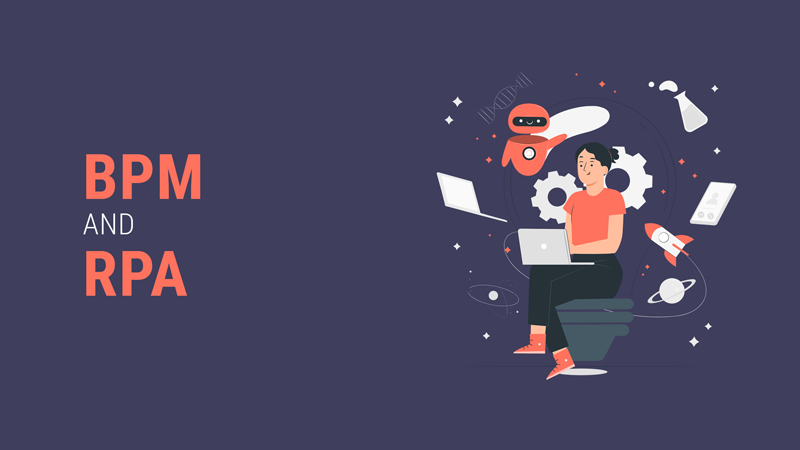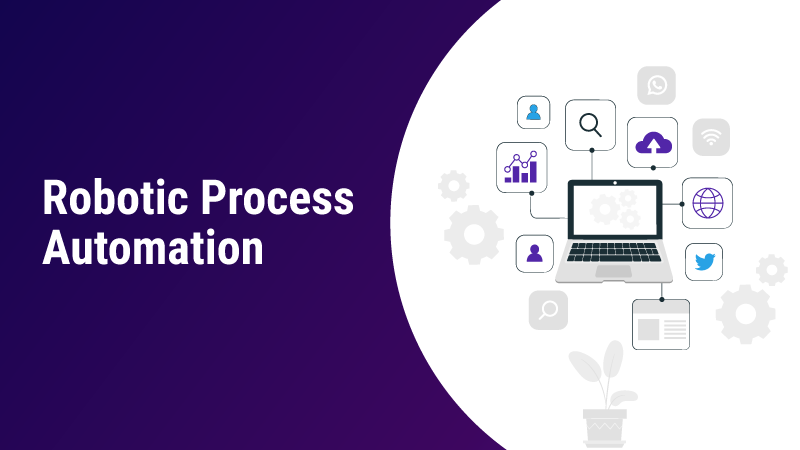How Can the Combined Power of BPM and RPA Benefit Businesses?

Accelerating the digital transformation in organizations and making it a whole success is a process that takes time and cannot be finished overnight. To make this process easier, businesses need to leverage some advanced and useful technologies. RPA and BPM are the two fundamental components of the technology, necessary to enable businesses to achieve digital transformation. Though both technologies are different from each other, they complement each other and create an evident transformation in the business processes, when implemented together.
Let us start with the definition of both technologies.
What is RPA?
Robotic Process Automation (RPA) tools are automation tool that makes use of software bots to perform manual repetitive tasks within a business organization. These RPA bots can emulate human actions and automate tedious tasks that were considered to be done by humans only. Thereby the bots allow human workers to concentrate more on tasks that require more creativity and human power rather than the mundane, repetitive, and boring tasks. It also takes away the burden of such time-consuming works from the human laborers. The implementation of RPA tools not only makes the process fast but also reduces the number of manual workers and requires very little effort.
The ability of RPA projects to enhance productivity, process quality, and speed is very significant while the companies try to meet the cost reduction requirements.
What is BPM?
Business Process Management software (BPM) has its focus on streamlining and rebuilding basic business processes to maximize efficiency. BPM can enhance business processes by evaluating its working in different situations, modifying them, examining the improvements, and optimizing them. This approach makes business organizations more efficient and capable of delivering products and services as per the changing needs. Below given is the life cycle of BPM which consists of five steps:
- Design – evaluating the current process to make improvements. Then with automation and standardization, make a plan for an ideal business process.
- Model – analyze how the process runs in different situations.
- Implement – implement the improvements made including standardization and automation.
- Monitor – monitoring the improvements made to evaluate the performance.
- Optimize – to keep enhancing the business process.
Benefits of Combining RPA and BPM in Businesses
Synergizing both of the advanced technologies has many benefits to point out. Here are some of them:
- Speedups the BPM machine – The most significant advantage of incorporating an RPA framework is that it accelerates the usual time-consuming tasks. This allows to clear clogged or impeded pipelines, which will enable BPM mechanisms to operate more efficiently and effortlessly. The RPA platform can work on particular sections of the infrastructure of BPM, which can lubricate the wheels and accelerate the cycle.
- Allows restructuring workforce – Implementing software bots to replace people performing tedious and monotonous jobs is having a positive and intense impact on the global industry. Giving an opportunity to the workforce to be freed from these trivial assignments offers many benefits as well. It enhances workforce motivation, increases their self-confidence, and it enables organizations to use those human resources in a variety of jobs – like the tasks that require the cognitive ability and imagination of the workers. In short, RPA facilitates you to operate an efficient workforce.
- Quick results – Business Process Management is a long-term and continuously evolving process and therefore requires a particular period to show the results. But with RPA, the whole process will be completed immediately and the results are noticeable since the beginning of the process. Integrating these technologies is always preferable for large organizations to get faster and highly productive results.
- Ideal Integration – Using technological systems will not disrupt your BPM even if you already have one. Robotic Process Automation, being a task-oriented, micro-level process, does not interfere with the BPM habitat. Since BPM enhances the process at the administrator level and RPA is a service-level tool, there is no overlap of both technologies. In fact, RPAs can give an extra boost to efficiency levels and further enhance your previous existing BPM process.
- Reduce bottlenecks due to swivel chair activities – Swivel chair activities are something organizations usually experience. Employees are required to enter data into different systems manually in these tasks. Swivel chair activities can result in clogs and costly errors in the smooth operation of a BPM framework. Since data entries in multiple systems are the exact synonym to repetitive and time-consuming work, they are ideal for RPA. With RPA and BPM, organizations can skip audit trails and reduce risks as processes are carried out, in the same way, every time.
- Optimizes APIs – APIs (Application program interfaces) are tools needed for the smooth operation of BPM systems, but repetitive use of API can make low-level tasks time-consuming. Making use of an RPA function to engage in APIs that are used repetitively will increase the effectiveness of a BPM system.
- Decision-making in approval processes – every decision in the approval process cannot be automated. With RPA and BPM, organizations can automate some of the decision-making tasks while leading the critical issues to the stakeholders for review. RPA reduces the manual processes involved in the small decisions and BPM automates authentication processes by creating a more efficient and defined authentication process and ensuring compliance.
Wrap up
While providing similar benefits and has matched a goal of automating repetitive tasks, RPA and BPM are very different when it comes to the area in which they function. Utilizing the strategic deployment of RPA systems will definitely help in improving the effectiveness of existing BPM infrastructure — this will help your business move forward. Apart from that, RPA robots can complete specific steps of end-to-end business processes. This can be done by eliminating the need for a BPM system to combine with established legacy systems or to create new interfaces.
In a world where efficiency is of utmost importance and margins are declining, the combined strength of RPA and BPM can give the required advancement in competition. Integrating RPA with BPM will significantly speed up the digital transition in businesses.
Get Started with our RPA ServicesBlogs by Category
AppForms Artificial Intelligence Blockchain Call Centers Chatbots Cloud Computing Data Management Design Digital Marketing Digital Transformation Enterprise Applications FinTech Insights LowCode Development Microsoft Mobile Apps News Office 365 Robotic Process Automation Security SharePoint Software Development Web ApplicationWhat is Robotic Process Automation? RPA Explained

2024-05-23 16:56:57